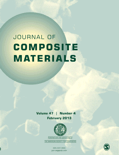
JOURNAL OF COMPOSITE MATERIALS
Scope & Guideline
Advancing the Future of Composite Materials
Introduction
Aims and Scopes
- Composite Material Characterization:
Research on the mechanical, thermal, and chemical properties of composite materials, enhancing understanding of their performance under various conditions. - Manufacturing Techniques:
Studies focusing on innovative manufacturing processes for composites, including additive manufacturing, automated fiber placement, and resin transfer molding. - Sustainability and Recycling:
Emphasis on eco-friendly materials and recycling strategies for composite materials, addressing the growing need for sustainable practices in materials science. - Advanced Composite Applications:
Exploration of new applications for composites in aerospace, automotive, construction, and other industries, highlighting their unique advantages. - Multiscale Modeling and Simulation:
Development of computational models for predicting the behavior of composites at various scales, from microstructural to macroscopic levels. - Failure Mechanisms and Damage Analysis:
Investigation into the failure modes of composite materials, including fatigue, impact, and environmental degradation, to enhance safety and reliability. - Interface and Interphase Studies:
Research on the interactions between fibers and matrices in composites, aiming to improve bonding and overall material performance.
Trending and Emerging
- Nanocomposites and Hybrid Materials:
There is a growing trend towards the incorporation of nanomaterials in composites, enhancing their mechanical, thermal, and electrical properties, and leading to the development of hybrid systems. - Smart and Multifunctional Composites:
Research into composites with multifunctional capabilities, such as self-healing, sensing, and energy harvesting, is rapidly increasing, driven by the demand for advanced materials in aerospace and automotive applications. - Bio-based and Sustainable Composites:
An emerging focus on bio-based composites, utilizing natural fibers and sustainable matrices, reflects a broader commitment to environmental sustainability and circular economy principles. - Additive Manufacturing of Composites:
The application of additive manufacturing techniques for producing composite materials is trending, as it enables complex geometries and rapid prototyping, catering to custom applications. - Advanced Computational Methods:
The integration of advanced computational techniques, including machine learning and artificial intelligence, for predicting composite behavior and optimizing material properties is gaining momentum. - Impact and Damage Tolerance Research:
There is an increasing emphasis on understanding the impact resistance and damage tolerance of composite materials, particularly under extreme conditions, to enhance safety and performance.
Declining or Waning
- Traditional Composite Materials:
There is a noticeable decrease in research focused solely on traditional composite materials (e.g., standard fiber-reinforced plastics) as interest shifts towards more advanced and multifunctional composites. - Basic Mechanical Testing:
Research centered on basic mechanical testing methods is declining as the field moves towards more sophisticated modeling and simulation techniques that provide deeper insights into composite behavior. - Single-Component Composites:
There is a waning interest in studies focused on single-component composites, with an increasing preference for hybrid and multi-material systems that offer enhanced properties. - Low-Performance Applications:
Research that targets low-performance applications for composites is decreasing, as the focus shifts to high-performance and specialty applications in demanding environments.
Similar Journals

ACTA METALLURGICA SINICA
Catalyzing Scholarly Dialogue in MetallurgyACTA METALLURGICA SINICA, established in 1978 and published by SCIENCE PRESS, stands as a preeminent journal in the fields of metallurgy and materials science. This journal is particularly revered for its contributions to Metals and Alloys, Mechanical Engineering, Geotechnical Engineering, and Mechanics of Materials, with a commendable Q1 ranking in Metals and Alloys and notable placements in other engineering disciplines. With a robust history of facilitating scholarly communication from 1978 to 1991 and consistently since 1996, the journal provides a vital platform for researchers and practitioners to disseminate significant advancements in material science. Despite being a subscription-based journal, ACTA METALLURGICA SINICA remains pivotal, holding a Scopus ranking that places it in the top tiers of its categories, fostering an environment ripe for innovation and collaboration. This ensures that the journal remains central to the ongoing discussions and developments within the metallurgy community, serving both academic and professional interests.
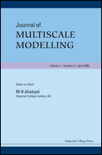
Journal of Multiscale Modelling
Innovative Approaches to Complex System AnalysisWelcome to the Journal of Multiscale Modelling, a reputable publication dedicated to advancing the fields of Modeling and Simulation and Computer Science Applications. Published by World Scientific Publishing Co Pte Ltd in Singapore, this journal serves as a vital resource for researchers, professionals, and students seeking to explore the intricate relationships between various scales of modeling systems. Since its inception in 2009, the journal has established a pivotal role within the academic community, evidenced by its Q4 ranking in both its respective categories and its interests in contributing to the understanding of complex systems through innovative simulation techniques. With an ISSN of 1756-9737 and an E-ISSN of 1756-9745, the journal encourages submissions that push the boundaries of current knowledge and methodologies. Though currently not open access, articles published in this journal are recognized for their scholarly rigor and innovation, aiming to foster collaboration across disciplines and enhance the practical applications of multiscale modeling techniques in various industries. Join us in exploring the vast potentials of multiscale modeling that lie ahead.
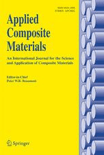
APPLIED COMPOSITE MATERIALS
Elevating Knowledge in Applied Composite ResearchAPPLIED COMPOSITE MATERIALS is a leading peer-reviewed journal published by Springer, dedicated to advancing the field of composite materials and their applications. With an ISSN of 0929-189X and E-ISSN of 1573-4897, this journal serves as an essential resource for researchers, professionals, and students interested in the innovative approaches and technological progress within the realm of composite materials. Based in the Netherlands, APPLIED COMPOSITE MATERIALS is recognized in the 2023 Scopus rankings, holding a prestigious Q2 quartile position in the Ceramics and Composites category, further exemplifying its impact with a rank of #59 out of 127 in materials science. The journal has been at the forefront of composite material research since its inception in 1994 and continues to offer open access to high-quality publications that address both theoretical and practical applications in the field. Researchers can count on this journal to disseminate cutting-edge findings and foster collaboration, driving innovation in composite material development.
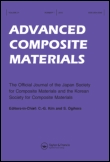
ADVANCED COMPOSITE MATERIALS
Unveiling Cutting-Edge Developments in Material ScienceADVANCED COMPOSITE MATERIALS, published by Taylor & Francis Ltd, is a leading peer-reviewed journal in the field of materials science, specifically focusing on the innovative development and applications of composite materials. With an ISSN of 0924-3046 and E-ISSN 1568-5519, this journal serves as a vital resource for researchers and professionals worldwide, examining cutting-edge advancements and methodologies in composites, ceramics, and mechanical engineering. Having secured a solid standing in the academic community, it boasts impressive Scopus rankings, such as #185 in Mechanical Engineering with a 72nd percentile and #46 in Ceramics and Composites, emphasizing its relevance and rigor. Although not an open-access publication, its insights are invaluable for those looking to explore, contribute to, and stay abreast of the latest breakthroughs in the field from 1991 through 2024. By targeting critical areas within mechanics and material sciences, the journal continues to foster innovation and scholarly discussion, making it an essential venue for specialists striving to advance the capabilities and applications of composite materials.

MECHANICS OF COMPOSITE MATERIALS
Unraveling the complexities of composite behavior.Mechanics of Composite Materials is a prestigious journal published by Springer, dedicated to the interdisciplinary field of mechanics and materials science, focusing primarily on the behavior of composite materials in various applications. With an ISSN of 0191-5665 and an E-ISSN of 1573-8922, the journal has established itself as a crucial platform for researchers and practitioners interested in understanding the mechanics of composite materials, which are pivotal in industries ranging from aerospace to biomedical engineering. Although the journal operates without an open-access model, it features a comprehensive archive dating back to 1979, offering a wealth of knowledge and insights for its readers. Ranked in the Q3 category in multiple fields including Biomaterials, Ceramics and Composites, and Mechanics of Materials, the journal provides valuable content for advancing research and innovation. Its Scopus rankings demonstrate the journal's relevance and impact across various scientific disciplines, making it an essential resource for academics and industry experts alike, keen to stay informed about the latest developments in composite material sciences.
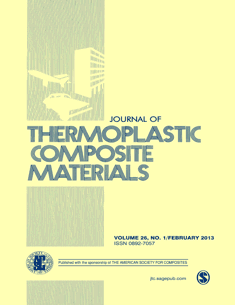
JOURNAL OF THERMOPLASTIC COMPOSITE MATERIALS
Unveiling the Potential of Thermoplastic CompositesJOURNAL OF THERMOPLASTIC COMPOSITE MATERIALS, published by SAGE PUBLICATIONS LTD, is a cutting-edge journal dedicated to advancing the field of thermoplastic composites and their applications within ceramics and condensed matter physics. With an ISSN of 0892-7057 and an E-ISSN of 1530-7980, the journal boasts a strong academic reputation evidenced by its impressive impact factor as well as its classification in the 2023 Q2 category for both Ceramics and Composites and Condensed Matter Physics. Ranked #60 in Condensed Matter Physics and #26 in Materials Science by Scopus, the journal plays a pivotal role in disseminating innovative research findings, trends, and advancements to a global audience. Spanning research from 1988 to 2024, it serves as an essential resource for researchers, professionals, and students alike, fostering collaboration and promoting knowledge in the ever-evolving landscape of thermoplastic composite materials. Although currently not open access, the comprehensive content and critical insights provided by this journal are invaluable for those engaged in cutting-edge research and practical applications in these fields.

INTERNATIONAL MATERIALS REVIEWS
Advancing Knowledge in Materials Chemistry and EngineeringINTERNATIONAL MATERIALS REVIEWS, published by SAGE Publications Inc, is a leading journal dedicated to the comprehensive analysis of contemporary research in the fields of materials chemistry, mechanical engineering, mechanics of materials, and the study of metals and alloys. With an impressive impact factor and a Q1 ranking across multiple categories such as Materials Chemistry and Mechanical Engineering in 2023, it ranks amongst the top journals for innovative materials research. The journal has a long-standing history since its inception in 1987 and continues to serve as a crucial resource for academics and professionals alike. Although it is not open access, it is renowned for its rigorous peer-review process and its commitment to disseminating high-quality materials science research globally. Researchers, students, and industry professionals benefit greatly from the journal's insightful reviews, both for the advancement of theoretical knowledge and practical applications within the fast-evolving materials field.

Journal of Composites Science
Advancing the Frontiers of Composite MaterialsThe Journal of Composites Science, published by MDPI, is a premier Open Access journal dedicated to advancing the field of composites and materials science. Launched in 2017, this innovative journal provides a platform for researchers, professionals, and students to share findings, methodologies, and insights related to composites, ceramics, and engineering applications. With an impressive Q2 ranking in both the Ceramics and Composites and Engineering (miscellaneous) categories for 2023, the journal is well-positioned within the academic community, ranking 48th out of 204 in miscellaneous engineering and 47th out of 127 in ceramics and composites according to Scopus. The journal's open-access model ensures that high-quality research is widely available to the scientific community, fostering collaboration and innovation. Situated in defensive Switzerland at ST ALBAN-ANLAGE 66, CH-4052 BASEL, the Journal of Composites Science is an essential resource for those seeking to stay at the forefront of the composites domain and drive progress in engineering practices.

World Journal of Engineering
Elevating Standards in Engineering Research ExcellenceWorld Journal of Engineering, published by EMERALD GROUP PUBLISHING LTD, stands as a premier platform for disseminating high-quality research across various engineering disciplines. Since its inception in 2014, the journal has built a reputation for its rigorous peer-review process and commitment to advancing knowledge in the fields of Civil and Structural Engineering, Electrical and Electronic Engineering, Geotechnical Engineering, Mechanical Engineering, and Mechanics of Materials. With its categorization in the Q3 quartile across multiple engineering domains and notable Scopus rankings, the journal positions itself as a valuable resource for researchers, professionals, and students seeking to stay abreast of innovations and critical developments in engineering. While the journal currently operates under a subscription model, its comprehensive scope ensures that it remains a vital reference point for contemporary engineering challenges and solutions throughout the United Kingdom and beyond.

TRANSACTIONS OF NONFERROUS METALS SOCIETY OF CHINA
Elevating the discourse on materials chemistry and engineering geology.TRANSACTIONS OF NONFERROUS METALS SOCIETY OF CHINA, published by Elsevier, is a premier academic journal that serves as a vital platform for researchers and professionals specializing in materials science, condensed matter physics, geotechnical engineering, and engineering geology. Established in 1994, this esteemed publication has maintained a robust focus on the latest developments in the nonferrous metals sector, reflecting its significant impact in the field with a Q1 categorization across multiple disciplines. With impressive Scopus rankings—placing it in the top 20% of journals in relevant categories—this journal is recognized for its quality and rigor, providing critical insights into metals and alloys, materials chemistry, and their applications. The non-open access format ensures a dedicated readership among professionals and academics seeking substantial and authoritative research articles. By fostering knowledge exchange, the journal strives to advance the understanding and application of nonferrous metals, making it an essential resource for anyone involved in material innovations and engineering solutions.